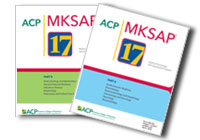 MKSAP has been trusted by internists since 1967 as the best resource for updating knowledge. MKSAP 17, available in Complete, Digital, and Print packages, consists of 11 comprehensive text chapters with related multiple-choice questions. You'll find 1,200 completely new questions to help you identify learning gaps, stay current, and gain the knowledge you need to provide the best possible patient care. MKSAP 17's original and high-quality questions evolve out of case studies and patient scenarios based on the latest evidence.
MKSAP has been trusted by internists since 1967 as the best resource for updating knowledge. MKSAP 17, available in Complete, Digital, and Print packages, consists of 11 comprehensive text chapters with related multiple-choice questions. You'll find 1,200 completely new questions to help you identify learning gaps, stay current, and gain the knowledge you need to provide the best possible patient care. MKSAP 17's original and high-quality questions evolve out of case studies and patient scenarios based on the latest evidence.
For more information on MKSAP 17, or to order your copy, visit mksap17.acponline.org.
MKSAP 17 Q & A
A 28-year-old woman is evaluated for bilateral eye pain and redness of 3 months' duration, which has recently worsened. She describes the pain as deep and constant and notes that it worsens at night. She also reports photophobia. She does not wear contact lenses. She has tried several types of over-the-counter eye drops without improvement in her symptoms. She is otherwise healthy and takes no medications.
On physical examination, the patient is afebrile, blood pressure is 100/62 mm Hg, and pulse rate is 94/min. BMI is 24. Ophthalmologic examination shows diffuse redness bilaterally, sparing the lids and iris. Visual acuity is normal. A nondilated funduscopic examination is unremarkable. The remainder of the examination is normal.
Which of the following is the most likely diagnosis?
A: Episcleritis
B: Keratoconjunctivitis sicca
C: Scleritis
D: Subconjunctival hemorrhage
Click here for the answer and critique.

